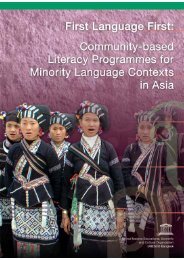Part II.pdf - MTB-MLE Network
Part II.pdf - MTB-MLE Network
Part II.pdf - MTB-MLE Network
You also want an ePaper? Increase the reach of your titles
YUMPU automatically turns print PDFs into web optimized ePapers that Google loves.
Based on the results of field surveying and research, it seems that one important cause for this<br />
problem has been identified. Language is a very important tool for thought and communication.<br />
It is the bridge for the exchange of ideas and emotions among people. Most ethnic groups have<br />
their own languages. They are accustomed to thinking and communicating in their mother tongue.<br />
Thus, when courses are taught in Chinese, which is a new language and even a new culture for<br />
them, they may remember the characters, but do not internally acquire the Chinese language.<br />
Regression to illiteracy is then inevitable. Language is a special kind of culture. Literacy does<br />
not mean that people can only recognize the characters or read text. Literacy is also a very important<br />
tool for preserving ethnic cultures.<br />
Therefore, the focal concern of the Government and other sectors of society has been to identify<br />
ways to make literacy for ethnic communities responsive to their real needs. In order to promote<br />
the sustainable development of minorities, literacy work should be carried out innovatively, and<br />
incorporate bilingual teaching. In relation to the above mentioned problem, RTCLE, funded by<br />
UNESCO Bangkok, has initiated the case study on “Bilingual Literacy for Ethnic Group’s<br />
Comprehensive Development – A Pilot Project for Lahu Nationality’s Innovative Practices in China.”<br />
Research methods and instruments<br />
Before the project began, a research group<br />
was formed that included Lahu language<br />
experts, literacy experts, officials from the<br />
Lancang education bureau, administrators of<br />
target communities, and primary school<br />
teachers from the project sites. This group<br />
gathered first-hand information through<br />
interviews, family visits, check lists and<br />
questionnaires. Special training was conducted<br />
for the project researchers and practitioners at<br />
the project sites. To ensure smooth project<br />
implementation, the research group worked<br />
together on information associated with the<br />
project and on problem-solving. During this implementation process, the action research method<br />
was also widely used.<br />
Lahu nationality in Lancang County and their language<br />
The Lahu are one of the most underdeveloped ethnic minorities in China. Educational provision<br />
for them started late, and has only improved slowly. There is a high illiteracy rate, which seriously<br />
hinders their social and economic development.<br />
The Lahu are one of the oldest nationalities in Asia. The population is scattered in hilly and<br />
semi-hilly areas in the Yunnan province of China, Burma, Thailand, Lao PDR, and Viet Nam. The<br />
total population is over 600,000.<br />
The Lahu in China live in Yunnan province. They number 400,000, which accounts for 66% of<br />
the total population.<br />
157
















